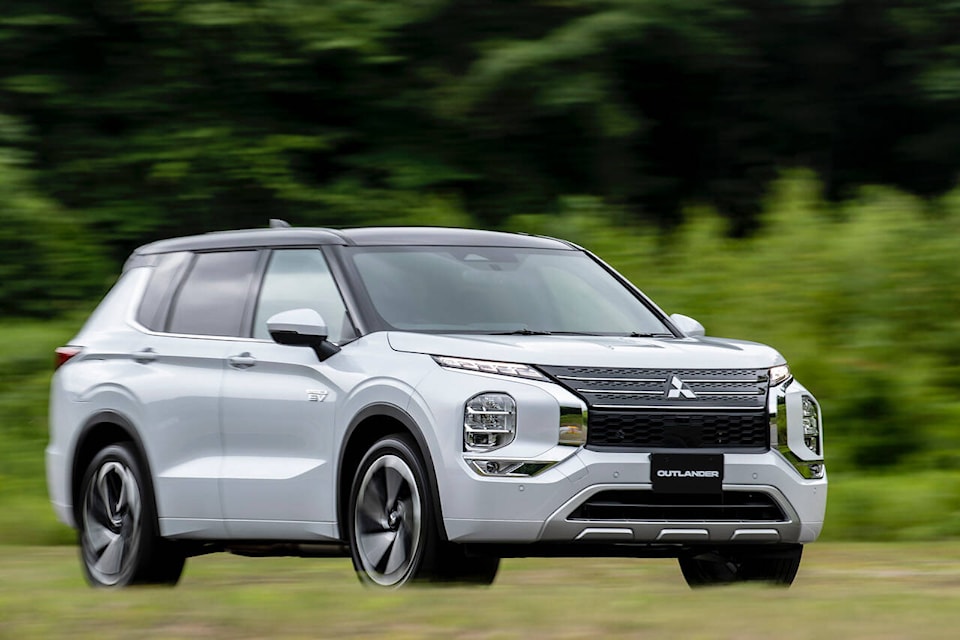By Keith Morgan
The Mitsubishi Outlander PHEV is as near a self-driving vehicle as I could handle, so to speak.
This plug-in hybrid electric all-wheel drive vehicle can be loaded with all the tech bells and whistles designed to enable your safe passage with minimum input from you, the supposed driver at the wheel.
The ES, LE and SEL entry trims are less loaded but have the most desired as standard features, such as auto emergency braking, forward collision and lane departure warning, but the GT-Premium tester had everything.
One new aid to me in the cruise control mode was most appealing. One tap and it reduces speed to a lowered posted speed limit at say a stretch of road under maintenance. And it auto recognizes the return to a higher limit once through the road works and tells you so!
I’m still wary of aids that lessen a driver’s control. I love driving and prefer to make the decisions that require one to stay alert. That said I do like the cruise control feature.
But let’s back up before commenting further on driving attributes and cast an eye over its appearance. Actually, there’s not much to say. The tester’s two-tone livery was interesting and I suppose it’s a bit more futuristic than its rivals in the mid-size SUV market.
The older I get, the less I am swayed by a car’s looks and I’m sure that people with $45,000-plus to spend on wheels are of an age that don’t look for the flash. I draw the line at plug-ugly but the Outlander is nowhere near fitting that description.
Anyway, beauty is only skin deep, as they say. Opening the doors reveals a spacious cabin with seats, front and rear, that were comfy and supportive on a recent four-hour trek to the Okanagan. There is a seven-seat capability but I suspect most days a roomy rear storage area will be the preferred configuration. And truthfully the final bench is for the grandkids only.
There’s a 12.3-inch digital instrument panel, which is simple to operate. Android Auto and Apple CarPlay apps seamlessly mesh with the system. There is a resident navigation system meaning you don’t have to drain your mobile phone’s data when in the United States. One of my bugbears as Regular Reader knows.
Ok, ready to unplug the fast-charger and press the Start button. Full gas tank and fully charged battery after four hours on my building’s charge point. Probably could be faster on a gas station network but no quibble here. Yes, working folks may plug in at work during the day but most will be overnight chargers so time of top up is not important.
The twin batteries got me to almost 60 kilometres into the Fraser Valley before the 2.4-litre, four-cylinder, gas engine silently fired up and took over propulsion. The hybrid operation thereafter then made for a more sprightly passing performance than previously experienced in a pure gas powered Outlander.
The S-AWC transmission system offers four terrain modes (tarmac, gravel, snow and mud) and three driving style modes (normal, eco and power). So much choice.
In the olden days, or to use that awful current cliche, back in the day, life was simple and we rated the fuel economy based on miles per gallon. Then the Metric Mafia made us learn about litres per 100 klicks. Pure EV is easy, sort of, we get gas equivalencies thrown at us and we exclaim “wow” when the alleged estimated consumption is a third of its gas equivalent.
Plug-in numbers get complicated. Pure EV mode in the Outlander boasts 3.6 L/100km. Pure gas mode is 9.2/8.7 L/100 kms. Ah, but you have to remember you got 60 klicks at 3.6 and in the hybrid-gas-mode you will better those numbers. On the journey I got a little over 6 litres per 100.
Simple, eh? What I take from these kind of numbers is the pure EV mode allows most work-a-day folks to get to and from their destination very cheaply.
And it’s been my belief for some time that for most people plug-in hybrids are the way to go for the next few years for fuel economy and practical daily use.
Finally, here are the numbers that are most likely to determine your purchase choice. The GT-Premium tester costs $57,048 plus taxes. The base price for the ES version, one of five main trims, is $46,538
keithrmorgan@hotmail.com
If you’re interested in new or used vehicles, be sure to visit TodaysDrive.com to find your dream car today! Like us on Facebook and follow us on Instagram
